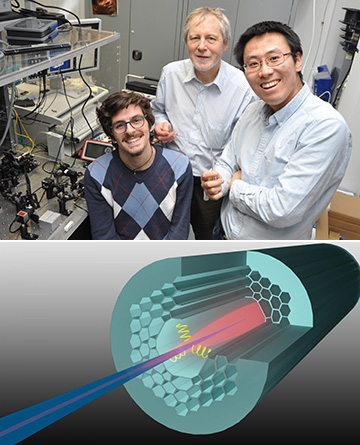
(Top) From left, Max Planck Institute researchers Riccardo Pennetta, Philip St.J. Russell and Shangran Xie. (Bottom) The tapered glass “nanospike” is trapped and self-aligned inside a hollow-core photonic crystal fiber. [Images: Philip Russell/Max Planck Institute for the Science of Light]
In a new type of optical trap, a laser beam aligns a tiny glass-fiber spike—thinner than the wavelength of the light—inside a hollow-core photonic crystal fiber (Optica, doi:10.1364/OPTICA.3.000277). The technique, according to the Germany-based researchers who devised it, also provides a way to launch very high-power laser light down an optical fiber without the external equipment to keep the beam aligned.
Tiny needles in an optical trap
The team, from the Max Planck Institute for the Science of Light in Erlangen, fabricated the so-called “nanospikes” out of single-mode silica fiber. These tiny needles had an overall diameter of 400 nm, with a tip only 105 nm wide. Scientists then positioned the nanospike in the hollow core of a photonic crystal fiber and launched a 1,064-nm-wavelength laser beam through the core of the single-mode fiber. When the light reached the thin tip of the spike, it began to spread out into the hollow core, only to reflect back from the boundary of the larger core. These optomechanical forces acting on the tiny spike create an optical trap.
According to Shangran Xie, a postdoctoral fellow in the research group of OSA Fellow and 2015 President Philip Russell, designing and fabricating the nanospike was one of the team's biggest challenges. The scientists needed the end of the single-mode fiber to form a long taper, one with enough mechanical stiffness to be inserted into the larger hollow-core fiber. The team combined thermal tapering and chemical etching to balance the optical and mechanical properties of the spike's tip.
Pushed to the center
“In our system, the measured optical trapping force acting on the nanospike is one order of magnitude stronger than conventional optical tweezers,” Xie says. The trapping mechanism in this experiment arises from the optomechanical interaction between two waveguides: the nanospike and the hollow-core photonic-crystal fiber. Inserting the spiked fiber inside the core of the larger fiber “perturbs the local electromagnetic field, providing a strong back-action that pushes back the nanospike in the core center,” Xie says. “This also allowed for the first time the stable optical trapping of complex shaped objects under high vacuum conditions.”
According to Xie, this new method of coupling light into hollow-core fibers offers the benefits of self-stabilization and self-alignment. The Max Planck Institute team wants to try this technique with gas-filled or liquid-filled hollow-core fibers, so that it can be extended to applications such as ultraviolet-light generation and biological cell trapping. In the realm of fundamental science, the researchers will use this system to measure optical forces in a high-vacuum environment to get a better understanding of gas dynamics and optomechanical effects on optical tweezers under conditions of low gas pressure.
